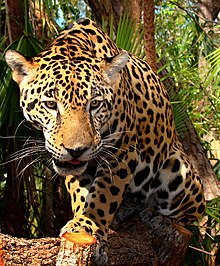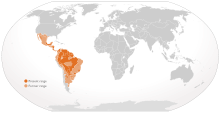जैगुआर इन्हें भी देखें सन्दर्भ दिक्चालन सूचीPanthera onca (Jaguar)Wild Cats of the World
IUCN Red List near threatened speciesजातियाँ (जीवविज्ञान) सूक्ष्मप्रारूप वाले लेखपैन्थेराउत्तर अमेरिका के स्तनधारीदक्षिण अमेरिका के स्तनधारी
फ़ेलिडाएकुलमांसाहारीउत्तरी अमेरिकादक्षिणी अमेरिकाजातिसिंहबाघसंयुक्त राज्य अमेरिकाआर्जेन्टीनातेन्दुएजबड़ा
| जैगुआर Jaguar | |
|---|---|
 | |
संरक्षण स्थिति | |
 Near Threatened (IUCN 3.1)[1] | |
वैज्ञानिक वर्गीकरण | |
जगत: | जंतु |
संघ: | कौरडेटा (Chordata) |
वर्ग: | स्तनधारी (Mammalia) |
गण: | मांसाहारी (Carnivora) |
कुल: | फ़ेलिडाए (Felidae) |
वंश: | पैन्थेरा (Panthera) |
जाति: | पैन्थेरा ओंका Panthera onca |
द्विपद नाम | |
Panthera onca (लीनियस, 1758) | |
 | |
| जैगुआर का विस्तार | |
जैगुआर (jaguar) फ़ेलिडाए कुल का एक शिकारी मांसाहारी जानवर है जो उत्तरी अमेरिका और दक्षिणी अमेरिका में पाई जाने वाली इकलौती पैन्थेरा (Panthera) जाति है। सिंह और बाघ के बाद जैगुआर बिल्ली (फ़ेलिडाए) कुल का तीसरा सबसे बड़ा और पृथ्वी के पश्चिमी गोलार्ध (हेमिस्फ़्येर) का पहला सबसे बड़ा सदस्य जानवर है। इसका निवास क्षेत्र उत्तर में संयुक्त राज्य अमेरिका के कुछ दक्षिणी हिस्सों से लेकर दक्षिण में आर्जेन्टीना के उत्तरी हिस्सों तक है।
हालांकि देखने में जैगुआर कुछ-कुछ तेन्दुए जैसा लगता है, लेकिन इसका शरीर तेन्दुए से बड़ा और अधिक शक्तिशाली होता है। इसका रहन-सहन और आदतें तेन्दुए से ज़्यादा बाघ से मिलती हैं। यह वनों में रहना पसंद करता है लेकिन मैदानों और झाड़ वाले इलाकों में भी घूमता है। इसे पानी के पास रहना पसंद है और बाघ की तरह इसे भी आसानी से तैरना आता है। इसे अकेला रहना और पीछा करके अपना शिकार मारना पसंद है। इसका जबड़ा और दांत बहुत मज़बूत होते हैं और सहज ही कवच वाले जानवरों को भी ग्रास बनाने में सक्षम हैं। आमतौर पर यह अपने शिकार को कानों के बीच काट कर सीधा कोपल की हड्डी तोड़कर मस्तिष्क पर जानलेवा घाव कर देता है।[2]
इन्हें भी देखें
- फ़ेलिडाए
- बाघ
- तेन्दुआ
- कूगर
सन्दर्भ
↑ Panthera onca (Jaguar), Assessors: A. Caso, C. Lopez-Gonzalez, E. Payan, E. Eizirik, T. de Oliveira, R. Leite-Pitman, M. Kelly & C. Valderrama; International Union for Conservation of Nature and Natural Resources, 2008, ... Jaguar extent of occurrence was estimated at 8.75 million km², and probability of long-term survival was estimated as high for over 6 million km² (Sanderson et al., 2002). Much of the jaguar's remaining habitat is the rainforest of the Amazon basin, which is of relatively low suitability (Torres et al. 2007). The jaguar is still an abundant species, but is threatened by habitat loss and persecution ...'
↑ Wild Cats of the World, Mel Sunquist, Fiona Sunquist, pp. 309, University of Chicago Press, 2002, ISBN 978-0-226-77999-7, ... The jaguar, however, also uses a third technique that is not seen in the other large felids: it bites through the animal's skull between the ears or horns. The thick skulls of horses and cattle killed by jaguars often have one or two holes punched through the temporal bone ...